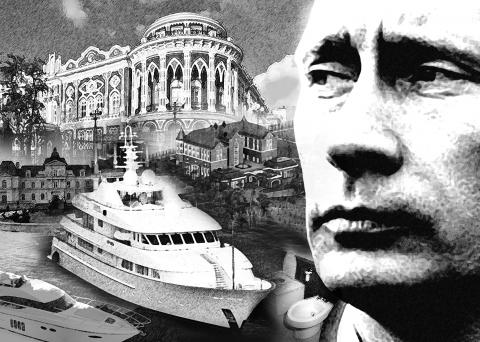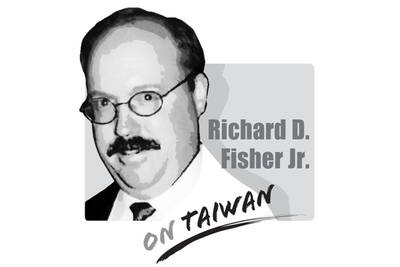To hear Russian President Vladimir Putin tell it, he works like a “galley slave,” pouring blood, sweat and tears into toiling for the Russian people with little personal gain in return.
Yet according to a new report by some of his harshest critics, Putin may be the richest “slave” in the world, reaping official perks as the powerful leader of a country with a long history of enriching its omnipotent tsars.
Watches in white gold, yachts decked out in the plushest of drapery and at least one flying toilet worth US$75,000 are among the presidential perks detailed by Boris Nemtsov, a former deputy prime minister turned Putin critic, and his co-author Leonid Martynyuk, a member of the opposition Solidarity movement, in a report released on Tuesday.

“Putin has led Russia for more than 12 years,” the authors wrote. “Losing popularity, Putin is maniacally clinging to power. It’s clear why.”
It is not just the “fear of losing his freedom, capital and property” or the influence of his inner circle, who have grown fantastically rich under his rule, they said. “One of the most serious reasons that forces Putin to hold on to power is the atmosphere of wealth and luxury to which he has become accustomed and which he does not want to give up.”
According to the authors, Putin has overseen a phenomenal expansion in the awarding of presidential perks. At his disposal are 20 palaces and villas, a fleet of 58 aircraft, a flotilla of yachts worth about 3 billion roubles (US$92.6 million), a watch collection worth 22 million roubles and several top-class Mercedes cars.
“We did not publish data on the cost of the clothes and things that Putin regularly uses: the suits, shoes and ties worth tens of thousands of dollars — mere trifles when compared to the villas, aeroplanes watches and cars,” they wrote.
The report, ironically titled The Life of a Galley Slave, is the latest salvo in the opposition’s attempt to discredit Putin as they continue to challenge the legitimacy of his return to the presidency this year. It could signal an attempt to expand the opposition beyond the urban middle class that comprises most of its ranks, highlighting the stark contrast in the way Putin lives compared with the average Russian.
“In a country where more than 20 million people can hardly make ends meet, the luxurious life of the president is a blatant and cynical challenge to society by a limitless ruler,” the report said.
With photographs of each palace, watch and aircraft, the report paints a colorful picture of the life enjoyed by Putin, and famously compared himself to a “galley slave” during a 2008 press conference.
There are the columned facades of palaces outside Moscow, in the southern resort of Sochi, and dozens more around the country. On an island in the center of Lake Valdai, stands a 930 hectare estate serviced by a 1,000-strong staff that includes a “presidential church, swimming pool, two restaurants, movie theater, bowling alley and concrete helipad.”
The authors compare Putin’s nearly two dozen official residences to the number held by other state rulers — two for the leaders of the US and Germany, and three for the president of Italy. Nine of the villas were built while Putin was at the helm of the country, they added.
The Russian president has long attempted to present an image of average Russian machismo, staging regular photo ops with factory workers and bikers. Images of his stark home life stand in contrast to the meetings he holds in the Kremlin’s gilded halls. During a televised meeting of his participation in Russia’s nationwide census in 2010, Putin appeared on a drab beige sofa in one of the two modest apartments he is officially registered as owning.
Putin last declared his income — US$115,000 — in December, a requirement to run in the March presidential vote, when his bank balance was revealed to be a mere US$179,612.
“And yet,” the authors said, “his lifestyle can be compared to the life of a Persian Gulf monarch or a flamboyant oligarch.”
Putin’s spokesman, Dmitry Peskov, could not be reached for comment. He has in the past called rumors of Putin’s personal wealth, revealed in diplomatic cables released by WikiLeaks, “completely stupid.”
Nemtsov and Martynyuk say the 58 aircraft Putin has access to comprise 43 planes and 15 helicopters. One of the airplanes, an Ilyushin-96, features an US$18 million cabin fitted out by jewelers and is said to have a toilet that costs US$75,000 alone. The report reveals four yachts, including the Olympia, which the authors dub “the real diamond in the Kremlin flotilla.” Fitted in rich mahogany, the five-floor yacht includes a jacuzzi and marble bathroom and costs US$50 million to maintain yearly, they allege.
The authors do not touch on Putin’s alleged personal wealth, instead highlighting how his lifestyle was afforded by taxpayer money which they say could have been better spent on improving the lives of the country’s citizens. Their report, dotted with footnotes, was mainly compiled from media reports.
“We absolutely cannot put up with this,” the authors wrote. “We think the lifestyle of those in power must become a subject of public discussion.”
Putin has attempted to maintain strict secrecy over his private life, with reports on his little-seen wife and two daughters considered all but taboo.
Speaking to a press conference in 2008, he said of his first two four-year terms as president: “All these eight years, I have labored like a galley slave, with all my strength. I’m pleased with the results of my work.”

On Sept. 3 in Tiananmen Square, the Chinese Communist Party (CCP) and the People’s Liberation Army (PLA) rolled out a parade of new weapons in PLA service that threaten Taiwan — some of that Taiwan is addressing with added and new military investments and some of which it cannot, having to rely on the initiative of allies like the United States. The CCP’s goal of replacing US leadership on the global stage was advanced by the military parade, but also by China hosting in Tianjin an August 31-Sept. 1 summit of the Shanghai Cooperation Organization (SCO), which since 2001 has specialized
The narrative surrounding Indian Prime Minister Narendra Modi’s attendance at last week’s Shanghai Cooperation Organization (SCO) summit — where he held hands with Russian President Vladimir Putin and chatted amiably with Chinese President Xi Jinping (習近平) — was widely framed as a signal of Modi distancing himself from the US and edging closer to regional autocrats. It was depicted as Modi reacting to the levying of high US tariffs, burying the hatchet over border disputes with China, and heralding less engagement with the Quadrilateral Security dialogue (Quad) composed of the US, India, Japan and Australia. With Modi in China for the
The Jamestown Foundation last week published an article exposing Beijing’s oil rigs and other potential dual-use platforms in waters near Pratas Island (Dongsha Island, 東沙島). China’s activities there resembled what they did in the East China Sea, inside the exclusive economic zones of Japan and South Korea, as well as with other South China Sea claimants. However, the most surprising element of the report was that the authors’ government contacts and Jamestown’s own evinced little awareness of China’s activities. That Beijing’s testing of Taiwanese (and its allies) situational awareness seemingly went unnoticed strongly suggests the need for more intelligence. Taiwan’s naval
A large part of the discourse about Taiwan as a sovereign, independent nation has centered on conventions of international law and international agreements between outside powers — such as between the US, UK, Russia, the Republic of China (ROC) and Japan at the end of World War II, and between the US and the People’s Republic of China (PRC) since recognition of the PRC as the sole representative of China at the UN. Internationally, the narrative on the PRC and Taiwan has changed considerably since the days of the first term of former president Chen Shui-bian (陳水扁) of the Democratic